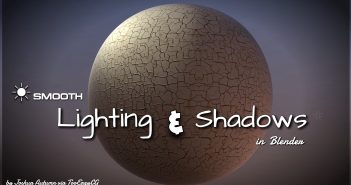Filmic Blender has been the hype lately, and this render gave me the urge to instantly download it.
Here is Gil Pinheiro's first version without Filmic (to the left) and with Filmic (to the right).
The Filmic version allowed him to get a better "SSS" look noticeably on the shell, by having the ability to increase the light value without blasting the image.
Have you guys tried Filmic yet? If so what do you think about it so far?







28 Comments
I've tried the filmic blender and loving it ever since
It's a must have
a future blender standard...
Yeah, i heard that will be the case :)
Very professional! I don't see me without Filmic anymore!
From what I understood from the development notes for blender they seem to work towards making it ship with blender.
- Production color profile "Filmic Blender".
Ah, nice!! In these moments we realize how an open source software works in syntony with the community!
It's amazing how much more depth and feel the filmic provides. Especially the rim lighting pops out, and the sss really stands out as well!
Haven't tried it out yet, seems like its a must have. Its a big step up towards the realism, or lets say a belieavable look.
Agreed, worth checking out i think :)
This is a huge step toward more perceived realism. Love it!!
A must have... A must have... A must have :)
Are you sure the images are not inverted there?
From what I had seen in BA forum about softer lights in Filmic, I thought the first image corresponded to Filmic.
By the way, in the second image the details in the shell of the snail are absolutely lost.
I deliver the info i find, i wasn't personally there when he did the render though :P.
But either way, it makes sense to me. The SSS becomes more apparent with stronger back light, which Filmic allows you to do apparently without killing the image. Also, the loss of details is probably because of the SSS figuration, but it still a more likely result from a strong back-light than the first image.
You are right, if the light coming from behind is much stronger than the front light, you should not see the details in the shell.
My question is, has the same light and SSS settings been used in the first image? So all the change in the shell comes just for having used filmic?
No, the typical case is NOT that using the same settings produces a better result, just by adding Filmic. In this case, because Filmic deals with light intensities better, the artist was able to use a light that was much brighter. If the settings in the second image were used without Filmic, the result would be a blown out, overexposed image.
Yep, Filmic set to default. Very happy with it.
Troy Sobotka rulezz.
Great to have someone contribute this much to the community, good to know x)
Good news!
er, am I wrong but is filmic simply an alternative way for Blender to display wide dynamic ranges? - in other words, filmic doesn't change the raw render result at all, only the viewport display of the render and the output of the compositor if it was used in the render pipeline? - I've done a bunch of tests and found that no matter what colour management is set to, the actual render (before the compositor pipeline) is a full dynamic range 32bit result that can be colour corrected (ie: managed) like any other render in any other compositing package after-the-fact - please correct me if I'm wrong - I believe that, if you don't use the Blender compositor, filmic doesn't touch the 32bits render result at all - am I missing something?
Have see this tutorial https://www.youtube.com/watch?v=m9AT7H4GGrA
If you haven't, you may get your answer there.
That's correct. Filmic doesn't operate on the 32bit data (exrs are always saved in a linear format). It's a LUT for crunching the HDR scene data into 8bit images. In theory you wouldn't use filmic until you are done with all your compositing and vfx.
ah, thanks, I suspected as much - is filmic just a well-tuned LUT or is it doing something extra under the hood, some kind of hard-coded "superLUT" cleverness that's additional to Blender's regular colour management curves and functionality?
The SSS effect is more visible in the Filmic blender render but the surface details of the snail is lost!
Indeed! I guess is a matter of amount of SSS. But I'm already saw this happen with real photo!
Filmic is now part of Blender Master and will be one of a few OCIO options.
I want to see added color proofing tools, on the fly, that overlay and give one Preview looks before they render.
This is really bringing back Blender and Cycles to my work pipeline. Incredible results with ease. The Andrew Price tutorial about it is really informative too. Now I finally understood why we had years and years of burned renders. It was all about dynamic range of the renderer.
Filmic very good, i love it. Tried on still unfinished interior - I was very impressed.
Made the transition with my work stuff recently from the default to Filmic and I think the results definitely speak for themselves, noticed a huge improvement. I had to tweak a few things, and experiment with my default lighting setups to find new defaults that work well for filmic, but it was more than worth it for the results.
The most obvious change I've seen at work, is an increase in the number of 'Wow!' moments I hear from others at work in response to images. Filmic just seems to add magic powder to everything, gives it that extra magic to impress people in ways my other renders weren't. Seriously loving it.